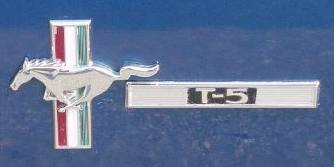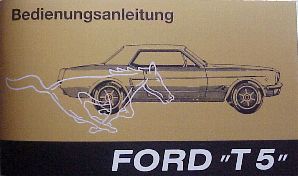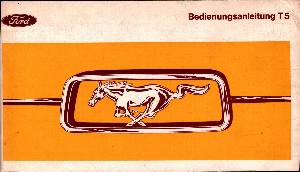
T-5 > Mustang incognito
The Mustang was built ex-factory as a T-5 from April 1964 - Dez. 1978
© Wolfgang Kohrn / T-5-Registry (co-registrar with Gary Hanson - based in Germany)

| History |
While the market introduction plans for the Mustang in the U.S. were under
consideration, Ford already intended to export the new Pony car to Europe, especially when
thinking of the potential customers among the US forces staff there. The market volume was recognised by Ford: Statistics shows us that in 1965 132.000 cars were registered for US army staff members in Germany only. The design studies of the Mustang were very well accepted in Europe, too. One of the first convertibles with a scheduled build code of 05C (5th. March) was sold to an Englishman on the 8th. of April already. But in Germany the main interest of Ford went to the US forces staff. In July 1965 Ford announced even to begin production in the Netherlands and started it in September 1965 in the Amsterdam Ford factory. But that is another story and has little to do with T-5s, although a few T-5s are known these days having been produced in Amsterdam. |
||||||||||||||||||||||||||||||||||||||||||||||||||||
|
Secret
Mission |
Unfortunately Ford had some initial problems in marketing the Mustang in
Germany. The name rights applied until 31.12.1978, so all Ford Mustang I and Mustang II versions and
even early 79 models (built until Dec. 78) exported to Germany had to be sold under the
name T-5. The two companies Krupp and Kreidler were cooperative at the starting point.
The 2 German companies initially asked for a fee of 10.000 $ for the name rights, but Ford
rejected to pay this amount. |
||||||||||||||||||||||||||||||||||||||||||||||||||||
|
|
Two types of T-5s have proved to be authentic according to original and present owners.
Military staff stationed in Germany could order their T-5 through the military PX-system.
The - let's call-it - U.S. staff T-5 types were equipped with a mp/h speedometer,
german civilians received a km/h-speedometer built in their car with specific
part nos.
|
||||||||||||||||||||||||||||||||||||||||||||||||||||
|
|
The T-5 name usage for the Mustang applied only for Germany at that time, not other european countries, however there are some reported inconsistencies: A 70 T5 (from Rod Hetzel,Texas) was delivered with T-5 ID plates listed on the original
invoice to Luxembourg. It is assumed that sometimes T-5 have been ordered by the
overseas
distribution center of Ford in Cologne (Germany) but finally upon order were delivered to
neighbouring countries. So far all known T-5s have only been built at the Dearborn and Metuchen factories. As all late 1965 and later Dearborn and Metuchen built cars usually have a body buck tag on the inner right or left fender or beside the cowl under the right fender on 71-73 Dearborn Mustangs, the buck tag is one of the best items to start identification of a real T-5, however also here inconsistencies have been found. 64 1/2 through 66 T5s are tagged with an X (for export) only on the body tag, 68 T5s
have a tag with "X W. GERMNY T5", on 70s to 74s a "T5" or also a
"X T5 W Germny" was found on their ID tags or buck tag. In one case a 70 has
been confirmed with only a 95 on the buck tag to be a T5 through its history.
|
||||||||||||||||||||||||||||||||||||||||||||||||||||
| DSO-Codes (Domestic or District Sales Order) | Usually DSOs of 90 to 95 can be accepted for T-5s, with only one 96 beeing reported of a
70 T-5. 99 has been found in most cases on New Zealand cars. Note that 90 to 98 DSO have
been reported also of other countries throughout the world, so it is no clear
identification for T-5s, only for export cars. It's obvious from the T-5 registry that DSOs for export cars changed upward almost every 2-3 months, especially for 90-94. DSO 95 was used for the last monthes of the year, which means for the new model. However there are also some inconsistencies in this matter. Kevin Marti expressed his opinion on our research that the DSO are not country-related, but sales volume oriented. Means a country could obtain a higher DSO between 90 and 99, if the volume grew over the year. A very logical explanation. Looking at the actual Ford files from 1967 onward revealed that the total number of a DSO like e.g. 94 has no relation to the T-5s exported. T-5s from 1967 onwards can be very clearly identified from the Ford database, so it becomes apparent that the DSO is not related to one country only. Which will tell other registrys also that with a DSO code only, you cannot relate to a specific country. Since a few years (as of 2019) there is a larger Export registry growing taken care of in France, if you are looking for other export cars than german, they may have more explanations on certain specials. |
||||||||||||||||||||||||||||||||||||||||||||||||||||
Literature (Owners
manuals) 1966  1971 |
Early T-5s for US forces members received an english owners manual with a stamp
on it
that was "In consideration of trademark rights - T5"
|
||||||||||||||||||||||||||||||||||||||||||||||||||||
|
|
Of most of the early years both english and German language special
T-5 brochures have
been found, another indication that two target groups (military staff & German
speeking citizens) were approached. This sales material however leads in some cases to
discrepancies, as the pictures and the text often vary obiously from the verified real
T-5
options. One example is the T-5 badging on the photos. |
||||||||||||||||||||||||||||||||||||||||||||||||||||
|
Conversions | |
The necessary conversion caused many headaches to the tooling companies and suppliers of Ford. European roads were said to be a little bit harsher - that's why at least for the 65/66
T-5s the suspension received special attention as well as the cooling. The German motor vehicle regulations also requested some conversions to be done. The single conversion items are explained later in detail. While in 1964 the T-5 conversion items (later called T-5 package) were
simply put into the trunk to be installed by the
dealer, from 1965 this procedure was no longer accepted by the German authorities and
conversions had to be done on the assembly line. That explains why mostly T-5s
were produced in a batch, still there might be exemptions in case of special or
urgent orders.
|
||||||||||||||||||||||||||||||||||||||||||||||||||||
| Deleted
"Mustang" name and T 5-emblems (medallion) |
The Mustang name elimination, which included for example different gas caps and wheel covers on early T5s was a real task for both the tool suppliers and Ford itself. Fender holes had to be punched on all models in another way and steering caps had to be altered. A 64 1/2 T 5 e.g. was found with a flexed steering wheel cap. The Mustang wording has just been scratched away, a consequence of the dealer instruction, which somebody followed in an unusual way. Still there is some discussion ongoing about the early T-5 emblems:
The reason might be that Ford did not have ready to go T-5-emblems, when the production began. The metal T-5 sign also carries a C5 engineering no., strengthening the above mentioned theory. From 1967 on through to early 1979 another fender emblem was used, which had a similar shape like the 66 GT badge. Of this badge there are 2 versions known - as we heard - from 2 different suppliers, the later one has some slight differences in the crown and the exact location of the mounting pins, so both are not really interchangeable.. On 68 T5s also the rear decklids were delivered without the Mustang lettering, and both
67s and 68s had a rectangular passenger dash emblem instead of the word Mustang.
1969 and 70 T-5s have the Ford letters above the T5 emblem. The 71-73 also had a special T-5 (written as T-Five) dash emblem
depending on console equipment, but only a T-5 emblem on the
fenders without Ford letters.
|
||||||||||||||||||||||||||||||||||||||||||||||||||||
|
German motor vehicle regulations resulted in a broad range of different T 5 equipment |
Usually a locking system attached to the steering column had to be installed. Evidence
for this special dealer installed device had been found on some 1966 and 67 T5s so far. Also
it is pictured and described in the German edition of the owner manual of a 1965.
Some of the other necessary changes referred to the headlights. As the "sealed-beam" U.S. headlight type was and still is not allowed by German motor vehicle regulations, the headlight configuration had to be completely exchanged. The German headlight set-up included new bulbs and rubber caps and for some model years also new ring retainers. All of the real T-5s should have changed headlights (from 1970 H4-light was used) and amber outside turn indicator lamps, because amber bulbs with white lenses - as used on some of the 67/68 Mustangs - were not allowed in those years. In addition the wiring
for the turn lamps had to be altered, because the parking lamp function was not accepted
within the turn indicator lamp. From 1970 on the turn indicating light also had
to be separated from the braking light and fused separatedly as well. For the necessary emergency flasher set up, different solutions have been found. While
some early T5s received a complete new flasher set-up with a special add-on package
(typically from BOSCH). Later T-5s used the factory installed steering column switch,
however sometimes different red control lenses at the dash cluster had to be retrofitted,
because at some places the motor vehicle inspection authorities required this. The German
regulations requested a big red emergency flasher control lens to be installed. On earlier
types this light was included most often in the switch, which was mounted in most cases on
the left lower dash part. The U.S. type of the rear single-bulb housing with integrated bi(tri)-function for
stop-(driving)light and turn light was usually not allowed on German and maybe other
European roads. Specifically the shut-off of the stop-light during cornering has been
critical for the approval engineers, although we must admit today that everything depended
upon the relationship between the dealer and the authorities, so only few T 5s have been
found with these alterations. In order to meet the requirement the housing was in some
cases bored and a bracket made for a second bulb. In other cases the same Ford bulb holder
as original used had been used, if available. In that case only a hole had to be bored the
same size as the original besides it. These alterations are more often reported of later
T 5s than of the early 64 1/2 to 66 T 5s. Different solutions have been found for the later side marker lamp. While the official
Ford instructions (e.g. for 70 T-5) requested to paint the side marker lamps as well as the
sports lamps on 71-73s black and dismount the bulbs, some cars could pass despite this
regulations with their regular side illumination. Some of the a.m. changes were also required for self-imported cars, so real
T-5s also
need the badging or buck tag mark. In connection with the right DSO 90-95(96) and other
marks it is part of the identification.
|
||||||||||||||||||||||||||||||||||||||||||||||||||||
|
Rare alterations |
Some early T-5s had towing brackets fixed to the front frame rails on both sides. The towing brackets are usually also demanded by the German regulations, however have not been found on all T-5s. Although especially later T-5 literature stated disc brakes as a standard equipment, many T-5s have been reported with drum brakes, especially those from U.S. staff. Autobahn flasher set ups have been found on some European cars, but were not typical
for T-5s. The tilt-steering wheel option is reported to be a no-go for T- 5s during that
days, however speed control equipment has been found on some T-5s, although sometimes
altered to a flasher-set-up. In the past 5 years we also found a prooven T-5
with the tilt-steering wheel listed on the Marti report, so consistency of rules
was not Ford strength in those years.
|
||||||||||||||||||||||||||||||||||||||||||||||||||||
|
Exact number of T-5s (for '67-73 unearthed (April 99, reported by Gary Hanson) |
Thanks to Kevin Marti from Marti Auto Works we finally got a more detailed picture of the T 5 numbers produced in 1967-1973. Kevin has bought from Ford Motor Company their computerized production datas and due to a good connection with Gary Hanson and our club offered the relevant information free of charge.. As 65/66-datas were definitely lost by Ford, we still have the numbers only for the period from 67-73.
Gary Hanson, the T-5-registry founder and owner in the US, estimated for decades that about 500 T-5s have been exported in 65 and again in 66. The magazine Hobby stated in its October 66 issue that from the sales start in 64 up to April 66 2500 Mustangs had been sold to Germans and 1000 to swiss people, but this might have been also a Ford promotion figure to hide correct sales figures, which were not really good. Following are the official figures for Ford US cars registrated in Germany. Be aware that they do not contain the US army staff owned Fords.
Today about 350 (55 in Germany) are still on the roads.
|
||||||||||||||||||||||||||||||||||||||||||||||||||||
|
68 Dash emblem
|
link to parts list |
||||||||||||||||||||||||||||||||||||||||||||||||||||
| Questions or Registering | Mail to T-5 registrar
Wolfgang
Kohrn If you do or did not get an answer from the former T-5 registry website...check back with us here. I'll continue the T-5 registry for Europe (which I do since 1993) and will be happy to include US based T-5s as well. |